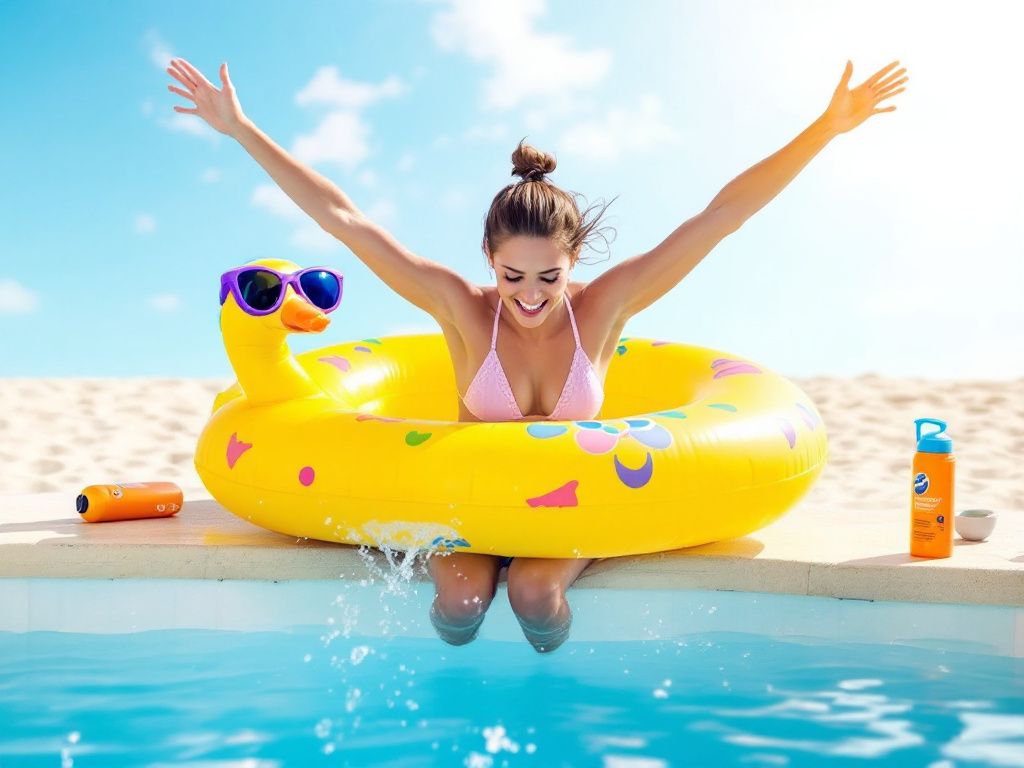So, you’ve got a pool party coming up, huh? Sounds like a fantastic way to beat the summer heat, spend quality time with friends, and just have a blast in the water. But before you dive in, let’s chat about something that’s often overlooked but super important—keeping your skin happy and healthy through all that watery goodness. I mean, have you ever noticed how your skin feels after a day at the pool? A little too tight, maybe a bit itchy? Yeah, that’s the water and all its effects at play. But don’t worry, I’ve got you covered with some relatable, easy-to-follow skin care tips.
Understanding Water Protection for Your Skin
The Poolside Struggle is Real
Alright, let’s get right into it. The chlorinated water in pools isn’t exactly your skin’s best friend. It’s necessary for keeping the pool clean and safe, but it can make your skin feel like it’s been through the wringer. Here’s why water protection is important: constant exposure to chlorine can strip away your skin’s natural oils, leaving it dry and irritated. That’s the problem we’re tackling today.
Here, we’re chatting about water protection in the sense of safeguarding your skin before, during, and after your swimming adventures. We’re gonna make sure you enjoy every splash without having to worry about dry patches or irritation later.
Chlorine Exposure and Your Skin
Chlorine exposure sounds a bit harsh, doesn’t it? It’s like your skin’s invisible nemesis at the pool. It’s crucial to understand what it does. While chlorinated water takes care of germs and bacteria, it also compromises your skin barrier. Think of it as an uninvited guest at your pool party who’s crashing more than having fun. If you’re not careful, you might end up hosting that guest longer than you’d like when all you wanted was a day of fun.
Diving into Water Protection Strategies
By now you might be wondering how on earth you’re supposed to keep enjoying the pool without turning your skin into a scaly mess. Fear not! There’re definitely ways to enjoy all of that aquatic fun while keeping your skin’s needs in mind. Let’s dive into some essential pre, post, and mid-swim water protection tactics.

Pre-Swim Skin Priming
Hydration Is Your First Line of Defense
When you’re all set to hit the pool, hydration starts before your skin even touches the water. Drinking plenty of water throughout your pool day is step one. It sounds too simple maybe, but staying hydrated means boosting your skin’s resilience against drying effects. Water in, healthy skin out—isn’t that what we all want?
Make It a Habit:
- Drink a glass of water before heading out.
- Keep sipping throughout the day. Got a fancy water bottle? This is the time to use it.
- Consider adding in electrolytes to keep it interesting and extra hydrating during long pool days.
Sunscreen is Non-negotiable
Let’s get one thing straight—there’s no skipping on sunscreen. The water and reflective surface of the pool may turn mild sunshine into an intense UV assault, and those rays don’t just fry your skin, but they enhance that drying, irritating feeling chlorine gives you. Grab a good-quality, water-resistant sunscreen with a high SPF—and go heavy on the application without holding back. And trust me, reapplying at least every two hours is key, especially after towel drying or heavy swimming sessions.
Pro-applicators know:
- Use at least one ounce (like filling a shot glass) to cover your whole body.
- Pay extra attention to frequently exposed spots like shoulders, back, and face.
- Don’t forget ears, top of the feet, and the back of your neck—a missed spot easily turns into a sunburn hotspot.
Moisturize Before You Go
You might assume skincare starts after you come out, but layering your skin with a simple moisturizer beforehand helps act as a barrier against chlorine assault. Think of it like a mini shield for your skin. This layer reduces the quantity of water and chlorine directly contacting your skin, which is super handy in minimizing dryness.

In-Pool Protection Tactics
A Quick Rinse is a Game-Changer
Interjecting some trivia here—a quick shower or rinse before you dive in actually protects your skin by saturating it with plain water. This simple action reduces how much chlorine-laden water is absorbed. It’s the stuff like towels, these small preparations that save you in the long haul.
Limit Water Exposure
Yeah, it sounds counterintuitive when the whole point is to embrace the water. Yet, even as you’re enjoying that Marco Polo game or relaxing in your floatie, being mindful of the time you’re in chlorinated water is helpful. Imagine it as giving your skin a breather too, instead of pushing it beyond its limits. You can still enjoy the vibe—make use of those lounge chairs!
Reapplication Ritual
Mid-party is when your sunscreen ritual comes back into play. Treat reapplying more as a fun break rather than a task. You’ll find your skin thank-you party is much larger than you’re guest list if you’re consistent. You can even mix it up by switching SPF types—from cream to spray—keeping things fresh and neat.
Post-Swim Skin Care: The Recovery
The After-Rinse is Crucial
That bleachy, chemical film you feel post-pool shouldn’t stay longer than it has to. Once you’ve had your fill of fun, hitting the shower as soon as possible to wash away the chlorine mix is important. Use a gentle body wash, nothing harsh, to cleanse. All you need is something effective in removing unnecessary residue without over-stripping the skin of its natural oils.
Lock in Moisture Immediately

Post-shower moisturization isn’t one-size-fits-all. After you’ve cleansed thoroughly, pack on a nourishing cream or lotion while your skin is still slightly damp, helping to lock in that moisture. Go for products with hyaluronic acid or ceramides for ultimate hydration and repair. They’re like a big glass of water for your skin, and just what’s needed to restore it to balance.
Your Post-Swim Beauty Bag Might Include:
- Aloe vera gel if your skin feels more tender than it should. It’s systematically effective in its cooling and calming properties.
- Coconut oil when your skin needs intense repair. Perfect on its own—or considered fused with your fave moisturizer.
- Hydrating masks for sensitive or irritated spots (hi, shoulders); they intensely boost hydration in targeted areas.
Must Re-hydrate From Within
It sounds repetitive, but reinforcing hydration post-pool with plenty of fluids—preferably water (and more water)—helps all facets of skin and body replenish. It’s not just closing a cycle—staying hydrated is a rolling action that keeps skin bounce and texture consistent.
Reassess and Repeat as Needed
What works for a day of splashes might differ per occasion or individual—so reassessment helps. Take note of what your skin responds to best, like which sunscreen felt comfortable and which moisturizer balanced things post-swim. Pool fun remains constant; our skincare rituals, however, are made personal.
Parting Thoughts on Pool Party Skin Care
Pool parties bring in joyful chaos with perhaps some bit of skin drama if not countered with smart and well-rounded water protection practices. The better you pre-plan, the better after-party season you’re going to have—not just counting curls from chlorine.
Definitely keep these tips handy and share a little rescue trick with friends if someone shares concerns over chlorine exposure. A lot of skin issues are prevented by just understanding how your skin interacts with water and by good habit-forming practices.
And there you have it! Dive into that pool party with these tips under your belt, allowing you to uphold amazing pool balancing, skin-protected days in the sun. Should we all cheers with our water bottles come pool party time? Absolutely!
Frequently Asked Questions
What is source water protection and why is it important?
Source water protection involves measures to prevent contamination of the sources of drinking water, such as lakes, rivers, reservoirs, and groundwater. It is crucial for reducing risks to public health, instilling customer confidence, and controlling water treatment costs. Protecting source water also has numerous environmental and societal benefits that are not achievable through treatment alone[1][3].
What are common sources of contamination for drinking water?
Common sources of contamination include animal waste, fertilizers, pesticides, herbicides, motor oil, gasoline, and other hazardous substances. These contaminants can reach the water source through runoff pollution, making it essential to prevent pollution from entering the water source[3].
How can individuals protect their drinking water sources?
Individuals can protect their drinking water sources by ensuring well covers, caps, and casings are in good repair, keeping hazardous chemicals away from wells, and maintaining clean areas around wells. Additionally, proper disposal of household chemicals, regular checks on septic systems, and avoiding overuse of fertilizers and pesticides are important steps[3][5].
What role do agricultural practices play in source water protection?
Agricultural practices play a significant role in source water protection. The 2018 Agriculture Improvement Act identifies source water protection as an explicit goal of agricultural conservation programs. Utilities can partner with agricultural programs to implement measures such as spill prevention and response planning, and addressing upstream nonpoint sources of pollution[1].
References










